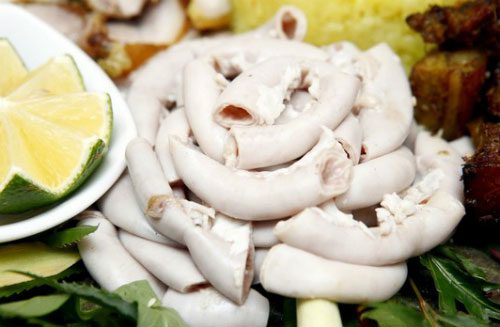Pork is a widely consumed food, not only delicious but also highly nutritious. However, some parts of the pig are recommended by doctors to be eaten in moderation.
Parts of the Pig You Should Eat Sparingly According to Experts
According to modern nutritionists, pork contains a significant amount of carbohydrates, fats, and proteins, as well as minerals like sodium and iron, which can support the body’s metabolism, promote hemoglobin production, and strengthen bones.
Pig Brain
Pig brain is rich in Niacin, Phosphorus, B12, and Vitamin C. However, statistics show that every 100 grams of pig brain contains up to 2500 mg of cholesterol, which is eight times the daily cholesterol requirement for an individual.

Every 100 grams of pig brain contains 2500 mg of cholesterol.
Therefore, this food does not enhance intelligence as many people assume; rather, it can lead to obesity, especially in children and individuals with blood lipid disorders or cardiovascular issues.
The protein content in pig brain is only 9 grams per 100 grams, significantly lower than other parts like lean meat.
Pig Blood
Pig blood is a popular organ food that is rich in iron. Eating pig blood in moderation can effectively prevent iron deficiency anemia, boost immunity, resist bacterial and viral invasion, and nourish the body.
However, doctors also advise against consuming too much pig blood at once, as the human body struggles to absorb large amounts of iron in a short period.
Excessive iron intake can lead to poisoning, which may result in symptoms such as vomiting, stomach pain, and other adverse health reactions.
Experts recommend consuming pig blood only once a week or 2-3 times a month. Additionally, it is important to ensure a balanced intake of other nutrients.
Moreover, not everyone is suitable for consuming pig blood. Individuals with gastrointestinal bleeding should avoid it, as well as those with high blood lipids, unstable blood pressure, or high cholesterol levels.
Pork Neck
Pork neck is tender and inexpensive, making it a popular choice. However, those who pay attention will notice that this part of the pig contains many lymph nodes, which are where toxins accumulate the most. If the cleaning process is not thorough, even high-temperature cooking will not eliminate these toxins. Therefore, it is advisable to avoid buying pork neck, especially pieces with visible lymph nodes resembling small bubbles.
Pork Hocks and Trotters
Pork hocks and trotters primarily contain protein, calcium, iron, vitamins A, B, and C, which are beneficial for the body.
However, excessive consumption can lead to high fat content, which may hinder digestion and cause bloating. Additionally, this fat is not good for individuals with elevated cholesterol levels.
Large and Small Intestines
Pig intestines are high in protein, making them an ideal food for recovering patients, especially those who have just undergone surgery.

Pig intestines are high in protein and cholesterol.
Many people enjoy eating pig intestines; however, this favorite dish carries potential health risks.
When we consume this, we may forget that the pig’s large intestine is where waste products from digested food are stored.
The intestines host numerous microorganisms, ensuring the presence of many parasites and harmful bacteria.
Furthermore, pig intestines contain high protein and cholesterol levels, which are not suitable for individuals with cardiovascular diseases, diabetes, high cholesterol, or metabolic disorders.
Moreover, if not properly cleaned and cooked, pig intestines can carry dangerous bacteria such as E. Coli, as well as bacteria that cause diarrhea, cholera, dysentery, and typhoid.
Blood Jelly
Among iron-rich foods, pig blood ranks at the top of the selection. As long as the pig is healthy, products made from its blood are safe to consume.
However, if you accidentally buy blood from sick or dead pigs, or blood that is no longer fresh, that poses a different issue.
Cooking pig blood makes it safe to eat, but many people prefer to consume it as blood jelly.
If the pig is infected with Streptococcus suis (whether sick or healthy carriers), a large amount of bacteria may be present in its blood. Consuming raw pig blood can lead to the bacteria entering the human body and causing illness.
Pig Lungs
The lungs are the main respiratory organs in humans and many other animals, including pigs. The trachea in pig lungs is densely covered with a complex structure, making it very difficult to clean. Additionally, pig lungs have a strong odor, making them hard to consume if not properly processed.
Pig Liver

The liver also contains many parasites such as worms and viruses.
Pig liver is known for its high nutritional content: protein, vitamins A, B, D, nicotinic acid, and folic acid. In particular, the Vitamin A content in pig liver is many times higher than that found in meat, fish, eggs, or milk.
Consequently, many people prefer to prepare liver for children, the elderly, and the sick without realizing that the liver is responsible for metabolizing and detoxifying in pigs, which means it also accumulates many waste products and pathogens, along with a certain level of toxins. The liver also harbors many parasites such as worms and viruses.
Therefore, when purchasing liver, it is essential to choose liver that has a distinct bright color, without white or red spots or any abnormal coloration. Before cooking, soak the liver in fresh milk for 30 minutes to help eliminate odors and toxins.
Pork Fat
Pork fat is not beneficial for health, especially for those with obesity, cardiovascular diseases, high blood lipids, or the elderly. Pork fat consists of saturated fatty acids, making it hard to digest and can raise blood cholesterol levels. Each gram of fat provides up to 9 kcal, while 1 gram of protein or sugar only provides 4 kcal, making pork fat a “foe” for dieters or those who are overweight.
Pork Skin
The protein in pork skin is difficult to digest. Pork skin has very low nutritional content but contains a high level of bad cholesterol, which can lead to cardiovascular diseases, high blood pressure, and obesity.
Moreover, if not properly cleaned and processed, pork skin can introduce many parasites and toxins into the human body.
Pig Kidneys
Pig kidneys are high in cholesterol. Eating them in large quantities over a long time can lead to coronary artery sclerosis. Those who enjoy consuming pig kidneys should be more cautious.
Changing dietary habits appropriately is beneficial for health, especially for those with high cholesterol levels. Regular consumption of pig kidneys may increase the risk of coronary artery disease and can cause angina, so heart patients should be particularly careful and limit their intake as much as possible. It is best for patients with myocardial infarction to avoid pig kidneys altogether.
Tips for Buying Pork
When shopping for pork, you can touch the surface of the meat. If the surface feels sticky, the pork is no longer fresh and should not be purchased.
If the pork has a very dark color, it means the meat has been stored for two to three days. Even if this type of meat is cheaper, it will not taste as good as fresh meat. Fresh pork should have a rosy color, so you should choose pieces that exhibit this color.
When buying pork, you should also sniff the meat for any unusual odors. Fresh pork will have a slight fishy smell, while spoiled pork will emit a strong, unpleasant odor.
Which Cuts Should We Buy at the Market?
According to food experts, the best and safest cuts of pork are belly, ribeye, tenderloin, and shoulder… because these cuts are very tender, fragrant, sweet, and chewy. When shopping, homemakers should consider purchasing these cuts. Additionally, choose pieces that have a bright pink color with white fat. When pressed, they should feel warm and elastic without any leakage. When cooked, they should retain their firmness and not release much water.


















































